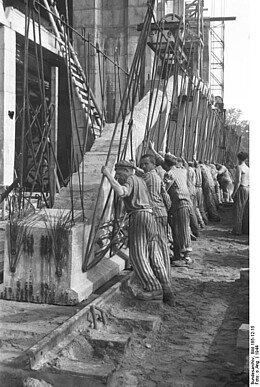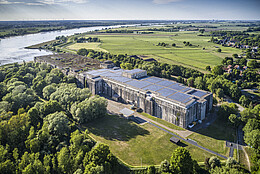Bremen-Farge
In 1943, prisoners from various camps were deployed to Bremen-Farge to construct submarine pens for the head construction department (Marineoberbauleitung) of the Kriegsmarine (German Navy). In light of the direction the war was taking, the German government began to turn its attention to the increased production of submarines. The pens built in Farge in Bremen under the code name "Valentin" had direct access to the Weser River and were intended to serve as shipyard a submarine station. The enormous structure – 419 metres long and up to 97 metres wide – was one of the most important construction projects undertaken by the Kriegsmarine. Up to 12,000 non-German slave labourers, concentration camp prisoners, POWs and prisoners from a "work education camp" were involved in the construction.
The SS established the satellite camp of Neuengamme concentration camp in Farge in October 1943. Around 3,000 men were sent to Bremen-Farge on several transports, making Farge one of the largest satellite camps of Neuengamme concentration camp. Most of the prisoners were from France, Poland and the Soviet Union.
The prisoners primarily worked for companies involved in the construction of the pens, many of which are still well-known construction firms today. Companies like Siemens and Krupp also had offices at the construction site. The prisoners were housed in an underground fuel tank, around four kilometres away from their place of work. The roof of this tank was camouflaged with sand, and the surface huts in the camp were built above it. The living conditions in the circular fuel tank and the working conditions in the pens were disastrous. Many prisoners died of starvation, disease and exhaustion. While we currently know the names of 553 prisoners who died here, the actual number of deaths is most certainly higher.
Construction stopped after the submarine pens were severely damaged by Allied bombing raids in late March 1945. On 7 April, the Bremen-Farge satellite camp became an important transit station for the evacuation of the Neuengamme satellite camps in the Bremen area. Prisoners from the camps Schützenhof, Blumenthal and Riespott in Bremen were initially transferred to Farge, which subsequently held over 4,000 – most likely almost 5,000 – prisoners. Farge was then also evacuated on 10 April. The first group of prisoners had to march straight to the collection camp in Sandbostel. Sick prisoners were loaded onto a train that was likely destined for Bergen-Belsen. However, it never reached the camp, winding up in Bremervörde instead, after a week of travelling aimlessly between Bremen and Hamburg. The prisoners who survived this transport were then taken from Bremervörde to Sandbostel. Yet another group of prisoners reached Bremervörde after a three-day march. They were then loaded into cattle cars and taken back to the main camp in Neuengamme via Winsen/Luhe.
From mid-1944 until the end of the war, Wehrmacht Captain Ulrich Wahl was the commander of the satellite camp. He was given the rank of Hauptsturmführer of the Waffen-SS Reserves when he assumed this post.
Period
October 1943 to 10 April 1945
Number of Prisoners
3000 Male Prisoners
Kind of Work
Construction of the "Valentin" submarine pens
Labor on Behalf of
Head construction department of the German navy (Marineoberbauleitung)
Location
Directions
By car: Take the autobahn A270. Stay on the autobahn, which after the Vergesack/Blumenthal exit turns into B74. Continue toward Farge. Turn right on Farger Straße, which becomes Rekumer Straße. Continue to Rekumer Siel road, and turn left.
By public transportation: Take a regional train from Bremen main train station (Hauptbahnhof) via Vegesack to Farge. From Farge station, take Bus 90 to the bus stop “Rekumer Siel”.
Memorial
The German Navy acquired the bunker in the 1960s and used part of the building as a depot for materials and equipment until the end of 2010. The grounds were taken over in the late 1950s by the Bundeswehr (German Armed Forces), who used the grounds as a training compound.
In 2010, the Senate of the Free Hanseatic City of Bremen commissioned the Federal Agency for Civic Education (Landeszentrale für politische Bildung) to establish and manage the memorial site Denkort Bunker Valentin, thus placing the bunker in civilian hands for the first time in its almost seventy-year history. The traces of construction and forced labour were slowly made visible again, and educational services were made available. The site currently offers a 90-minute tour, which must be booked ahead of time, in which visitors learn about the bunker and the outside areas.
Contact
Individuals and groups can book a tour on the Internet at www.denkort-bunker-valentin.de or by phone by calling +49 4 21 - 69 67 36 70. The tours cost a fee.
Tours of the Grounds of the Former Worker’s Camp
The association Geschichtslehrpfad Lagerstraße (Lagerstraße History Trail) offers tours of the area where the camp for forced labourers was located. For more information, please visit: www.geschichtslehrpfad.de
Other Services:
Dokumentations- und Lernort Baracke Wilhelmine (Wilhelmine Barracks Documentation and Education Centre), An der Kaserne 122, 28790 Schwanewede, www.baracke-wilhelmine.de
Projekt „Internationale Friedensschule Bremen“ (International Peace School in Bremen Project), www.friedensschule-bremen.de


